
WB analysis of EL4 cell lysate in (A) the absence and (B) the presence of blocking peptide using GTX31569 OLIG2 antibody. Working concentration : 1 microg/ml
OLIG2 antibody
GTX31569
ApplicationsWestern Blot, ELISA, ImmunoHistoChemistry, ImmunoHistoChemistry Paraffin
Product group Antibodies
TargetOLIG2
Overview
- SupplierGeneTex
- Product NameOLIG2 antibody
- Delivery Days Customer9
- Application Supplier NoteWB: 1 - 2 microg/mL. IHC-P: 5 microg/mL. *Optimal dilutions/concentrations should be determined by the researcher.Not tested in other applications.
- ApplicationsWestern Blot, ELISA, ImmunoHistoChemistry, ImmunoHistoChemistry Paraffin
- CertificationResearch Use Only
- ClonalityPolyclonal
- Concentration1 mg/ml
- ConjugateUnconjugated
- Gene ID10215
- Target nameOLIG2
- Target descriptionoligodendrocyte transcription factor 2
- Target synonymsBHLHB1, OLIGO2, PRKCBP2, RACK17, bHLHe19, oligodendrocyte transcription factor 2, basic domain, helix-loop-helix protein, class B, 1, class B basic helix-loop-helix protein 1, class E basic helix-loop-helix protein 19, human protein kinase C-binding protein RACK17, oligodendrocyte lineage transcription factor 2, oligodendrocyte-specific bHLH transcription factor 2, protein kinase C-binding protein 2
- HostRabbit
- IsotypeIgG
- Protein IDQ13516
- Protein NameOligodendrocyte transcription factor 2
- Scientific DescriptionThis gene encodes a basic helix-loop-helix transcription factor which is expressed in oligodendroglial tumors of the brain. The protein is an essential regulator of ventral neuroectodermal progenitor cell fate. The gene is involved in a chromosomal translocation t(14;21)(q11.2;q22) associated with T-cell acute lymphoblastic leukemia. Its chromosomal location is within a region of chromosome 21 which has been suggested to play a role in learning deficits associated with Down syndrome. [provided by RefSeq, Jul 2008]
- Storage Instruction-20°C or -80°C,2°C to 8°C
- UNSPSC12352203
References
- Tosuner Z, Geçer MÖ, Hatiboğlu MA, et al. BRAF V600E mutation and BRAF VE1 immunoexpression profiles in different types of glioblastoma. Oncol Lett. 2018,16(2):2402-2408. doi: 10.3892/ol.2018.8919Read this paper
- Rissi DR, Levine JM, Eden KB, et al. Cerebral oligodendroglioma mimicking intraventricular neoplasia in three dogs. J Vet Diagn Invest. 2015,27(3):396-400. doi: 10.1177/1040638715584619Read this paper

![ELISA analysis of antigen using GTX60398 OLIG2 antibody [1G11]. Red : Control antigen 100ng Purple : Antigen 10ng Green : Antigen 50ng Blue : Antigen 100ng](https://www.genetex.com/upload/website/prouct_img/normal/GTX60398/GTX60398_20170912_ELISA_w_23061123_935.webp)



